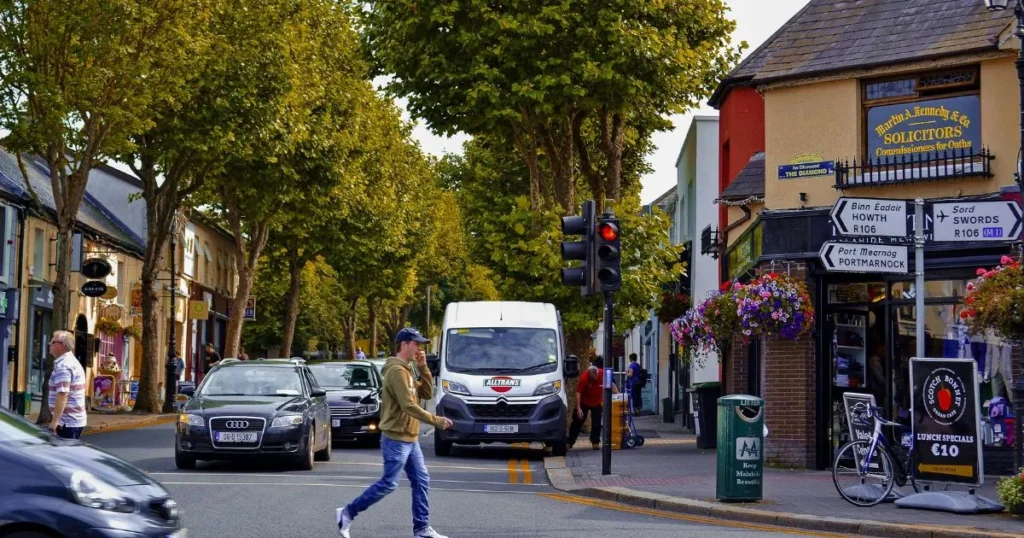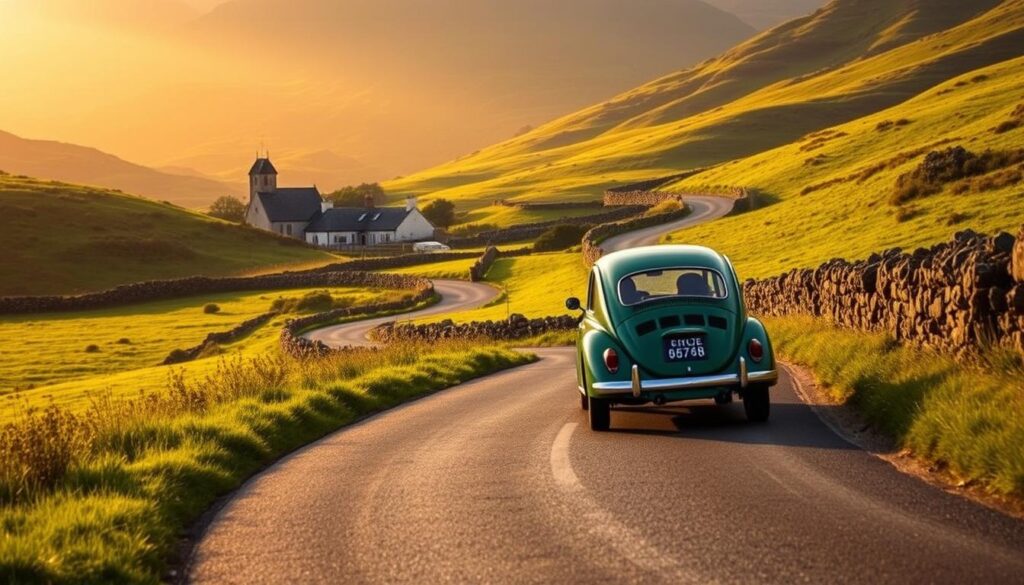Top 10 Tips for Planning All Exclusive Trips to Ireland
Ireland is a land of enchanting beauty and timeless charm. From the moment I stepped on its green land, I knew why so many love it. Planning a trip here is more than making a list. It’s about making memories that change you.
Your trip to Ireland can be more than just a visit. Visiting Ireland offers the opportunity to explore one of the world’s most breathtaking landscapes. You can find historic castles, stunning coastlines, and lively culture. Every trip to Ireland is an adventure you’ll never forget.
Getting ready for an Irish adventure takes careful planning. Understanding Ireland’s weather and choosing your destinations wisely are key to a great trip. This guide is designed to help you craft a truly unforgettable Irish adventure.
Table of Contents
Understanding Ireland’s Travel Seasons and Weather Patterns
Planning ireland tours needs careful thought about the country’s climate and seasons. Ireland’s countryside transforms dramatically with the seasons.This offers different experiences for those exploring celtic culture.
Ireland’s weather is known for being unpredictable. You might see different seasons in just one day. Knowing these patterns helps you get ready for a memorable trip across the Emerald Isle.
Peak Season Travel Insights
In July and August, ireland tours are at their busiest. Travelers can look forward to:
- Longest daylight hours
- Many festivals
- Warmer weather (compared to other times)
- More tourists
Weather Preparation Strategies
Packing for the irish countryside means being flexible. You should bring:
- Waterproof jacket
- Layered clothes
- Comfortable shoes
- Light umbrella
Shoulder Season Advantages
Traveling in April, May, June, September, or October gives you a unique window into authentic Celtic traditions. These months have:
- Lower travel costs
- Fewer tourists
- Mild weather
- Real local interactions
Timing your visit wisely will enhance your Ireland travel experience. This way, you avoid common travel problems.
Essential Transportation Options for Trips to Ireland
Planning your dublin travel adventure needs careful thought about how you’ll get around. Ireland has many ways to make your trip easy and fun.
Looking at ireland travel packages shows you many ways to see the country. You can explore beautiful landscapes and lively cities easily.
Car Rental Insights
Getting a car lets you travel Ireland freely. Keep these key tips in mind for a smoother journey:
- Remember to drive on the left side when navigating Ireland’s roads
- Rental cars are great for rural areas
- Bring an international driving permit
- Choose small cars for Ireland’s narrow roads
Public Transportation Options
Ireland’s public transport links cities and towns well:
- Trains connect big cities
- Bus networks cover lots of areas
- City buses in Dublin, Cork, and Galway
Airport Connections
Ireland has five international airports to make your travel easier:
| Airport | Location | Key Connections |
|---|---|---|
| Dublin Airport | Eastern Ireland | Most international flights |
| Shannon Airport | Western Ireland | Access to western regions |
| Cork Airport | Southern Ireland | Regional and international routes |
Pro tip: Book your transport early to get better prices and availability for your ireland travel packages.
Your choice of transport greatly affects your Irish trip. Pick what fits your needs, budget, and travel plans.
Choosing Strategic Base Locations Across the Emerald Isle
Planning your ireland vacations means picking the right place to stay. Your base location greatly affects your trip’s quality. The perfect spot offers comfort and easy access to amazing sights.
Choosing the right location lets you explore irish castles and beautiful landscapes better. Each part of Ireland has its own special places to stay. These can make your trip truly unforgettable.
Dublin and Eastern Ireland Accommodations
Dublin makes an excellent starting point for any Irish journey. It might cost more, but you get access to history and modern comforts. Here are some options:
- Boutique hotels in city center
- Historic bed and breakfasts
- Modern apartment rentals
Western Ireland Lodging Options
Western Ireland offers stunning countryside stays. Galway and nearby areas have unique places to stay that show Ireland’s rural beauty:
- Coastal country inns
- Traditional farmhouse stays
- Luxury countryside resorts
Southern Ireland Hotel Selection
Southern Ireland has great places to stay, like Cork and Killarney. Accommodation options range from luxurious hotels to charming rural retreats:
- Scenic mountain view hotels
- Romantic castle hotels
- Family-friendly resorts
Remember, where you stay greatly affects your trip. Choose well for an amazing Irish journey.
Must-Visit Destinations Beyond Dublin
Dublin is amazing, but Ireland’s real charm is in its landscapes and history. Exploring the Irish countryside will show you incredible places that touch the heart of this magical island.
The Cliffs of Moher are a natural wonder on Ireland’s west coast. These cliffs, 702 feet high, offer views that will leave you breathless. You can walk paths and take amazing photos, feeling the beauty of Ireland.
- Cliffs of Moher: Spectacular coastal views
- Ring of Kerry: Scenic driving route through southwest Ireland
- Killarney National Park: Stunning natural wilderness
- Dingle Peninsula: Picturesque coastal region
The Ring of Kerry offers one of Ireland’s most scenic and unforgettable drives. This 111-mile route takes you through Ireland’s most beautiful spots. You’ll see quaint villages, ancient sites, and stunning coastlines, showing off Ireland’s beauty.
Killarney National Park is a haven for nature lovers. It has lakes, mountains, and forests for hiking and photography. It’s a chance to dive into Ireland’s untouched wilderness.
“To truly understand Ireland, you must venture beyond the cities and explore its magnificent countryside.” – Irish Travel Experts
Pro tip: Rent a car to see these places at your own speed. The Irish countryside is best enjoyed with freedom and spontaneity. This way, you can stop for unexpected views and enjoy the journey.
Crafting Your Perfect Irish Itinerary
Planning an unforgettable trip to Ireland needs careful thought. Your journey should mix exploration, cultural experiences, and practical planning.
When planning your Dublin adventure, aim for a flexible schedule. Immersing yourself in Celtic culture will help you make the most of your Irish adventure.
Balancing Urban and Rural Experiences
A good Irish itinerary should mix city life with countryside peace. Consider these planning tips for a smoother trip:
- Plan to spend at least two to three days discovering Dublin’s rich heritage
- Set aside 4-5 days for the countryside
- Leave room for unexpected finds and local chats
Time Management Between Locations
Travel smart by planning your route well. Use this time guide:
| Travel Segment | Recommended Time | Key Considerations |
|---|---|---|
| City Exploration | 2-3 days | Museums, historical sites, cultural experiences |
| Rural Exploration | 4-5 days | Countryside tours, coastal regions, traditional villages |
| Travel Between Locations | 1-2 days | Driving, public transportation, rest periods |
Stay flexible to accommodate Ireland’s unpredictable weather
Ireland’s weather is famously changeable, so be prepared. Pack versatile clothes and add extra time to your plan for weather changes.
Pro Tip: Pack a lightweight waterproof jacket and stay adaptable in case weather conditions shift.
Engage with Irish culture through meaningful local interactions

Planning your ireland vacations means diving into the heart of celtic culture. Understanding Ireland’s unique social fabric is key. The concept of “craic” opens the door to the Irish spirit. It’s a mix of fun, conversation, and real connection that defines local interactions.
Irish pubs offer some of the most authentic and lively cultural experiences. They’re living museums of local traditions. You’ll be surrounded by:
- Live traditional music sessions
- Storytelling rich with local folklore
- Spontaneous dance performances
- Warm conversations with locals
To get the most out of your cultural experience, follow these tips:
- Learn a few basic Irish phrases
- Respect local customs and etiquette
- Participate in community events
- Listen more than you speak
“The soul of Ireland lives in its people, not just its landscapes.” – Traditional Irish Saying
Your journey through Ireland is about connecting deeply with its rich culture, not just ticking off tourist attractions. It’s about connecting with a culture that values life, story, and community. Embrace the craic, and you’ll bring back memories far more valuable than any postcard.
Budgeting for an All-Inclusive Irish Adventure
Planning your trip to Ireland needs careful budgeting. It’s entirely possible to enjoy a dream Irish getaway without breaking the bank. Knowing how to budget helps you enjoy all Ireland has to offer without overspending.
Travelers can find trips to Ireland that fit any budget. Let’s look at some key money matters for a memorable Irish trip.
Accommodation Cost Planning
Accommodation prices in Ireland vary a lot. You can choose from cheap hostels to fancy hotels and cozy B&Bs.
- Hostels: €15-€30 per night
- Budget Hotels: €50-€100 per night
- Mid-Range Hotels: €100-€200 per night
- Luxury Accommodations: €200-€500+ per night
Transportation Budget Considerations
Transport costs can affect your budget. Here are ways to get around Ireland:
| Transportation Method | Estimated Daily Cost | Pros |
|---|---|---|
| Public Transit | €10-€20 | Affordable, eco-friendly |
| Rental Car | €30-€60 | Flexibility, scenic routes |
| Organized Tours | €50-€150 | Comprehensive experiences |
Entertainment and Activity Expenses
Plan for activities that make your trip special. Many attractions have affordable entry fees:
- Castle Tours: €10-€20
- Museum Entries: €5-€15
- Guided Walking Tours: €15-€30
- Pub Experiences: €10-€25
Tip: Get the Heritage Card for cheaper entry to many sites. Non-EU visitors can also get tax back on their purchases, saving more money.
Navigation and Driving Tips for Irish Roads

Getting ready for trips to Ireland means learning about its unique driving scene. Exploring Irish roads is an exciting adventure for those eager to see the beautiful countryside. Driving in Ireland requires special care and preparation.
When you start your journey in Ireland, you’ll notice driving is different. One of the biggest adjustments for visitors is driving on the left side. This can be tricky for American travelers at first.
- Always drive on the left side of the road
- Familiarize yourself with local road signs
- Be prepared for narrow rural roads
- Watch for livestock and unexpected obstacles
Rural roads in Ireland are special challenges. Narrow, winding lanes often have high hedgerows that can limit visibility. Many countryside roads are single-track, requiring careful navigation and occasional pulling over to let oncoming traffic pass.
| Driving Tip | Recommendation |
|---|---|
| Speed Limits | Kilometers per hour (km/h), not miles |
| Road Types | N roads (national), R roads (regional) |
| Emergency Contact | 112 or 999 for assistance |
“Driving in Ireland is an adventure that calls for good preparation and a spirit of flexibility.” – Irish Tourism Board
Rental car insurance is key. Choose comprehensive coverage that includes windshield and tire protection. Check your credit card perks, as many offer additional rental car insurance coverage.
With these tips, you’ll drive confidently through Ireland’s magical roads. Your trip will transform into an unforgettable exploration of Ireland’s breathtaking landscapes.
Key Strategies for Booking and Reservations
Planning your ireland travel packages needs smart booking for a smooth trip. You must prepare well and act fast when booking exclusive trips to ireland.
For a great ireland tour, know when and how to book key reservations. Early planning can turn a good trip into an amazing one.
Advance Booking Timeline
- 8-12 months before travel: Book international flights
- 6-9 months in advance: Secure accommodation in popular destinations
- 3-6 months ahead: Reserve priority attractions and unique experiences
- 1-2 months before departure: Confirm restaurant and special tour bookings
Priority Attractions and Tours
Some Irish attractions need early booking to get in. Major attractions like the Guinness Storehouse, Trinity College, and the Cliffs of Moher often book up quickly during peak seasons.
| Attraction | Recommended Booking Window | Peak Season Availability |
|---|---|---|
| Book of Kells | 3-4 months in advance | High demand |
| Guinness Storehouse | 2-3 months ahead | Limited slots |
| Cliffs of Moher Tour | 1-2 months before travel | Rapid bookings |
Restaurant and Experience Reservations
For fine dining and special experiences like traditional music sessions and castle stays, plan early. Top restaurants in Dublin, Galway, and Cork book up fast in tourist season.
“The early bird catches the best Irish experiences!” – Irish Travel Wisdom
Book your ireland travel packages with flexibility. While early reservations are key, also leave room for unexpected finds that make your trip unforgettable.
Conclusion
Planning trips to Ireland needs careful thought and an open mind. Your journey will mix history with culture, creating unforgettable moments. By following this guide, you’re ready for an amazing Ireland vacation.
Understanding Ireland’s unique pace is key. You’ll explore scenic roads and find hidden spots in villages. This guide helps you create a journey that shows off Ireland’s beauty and warmth.
Being flexible is crucial in Ireland. Weather changes, local tips lead to new finds, and chats with locals create lasting memories. Embracing the unexpected makes your trip truly special.
Start planning your Irish trip with curiosity and respect. Each area has its own charm, from Dublin’s history to the wild west coast. With careful planning and a sense of adventure, your dream vacation awaits.

